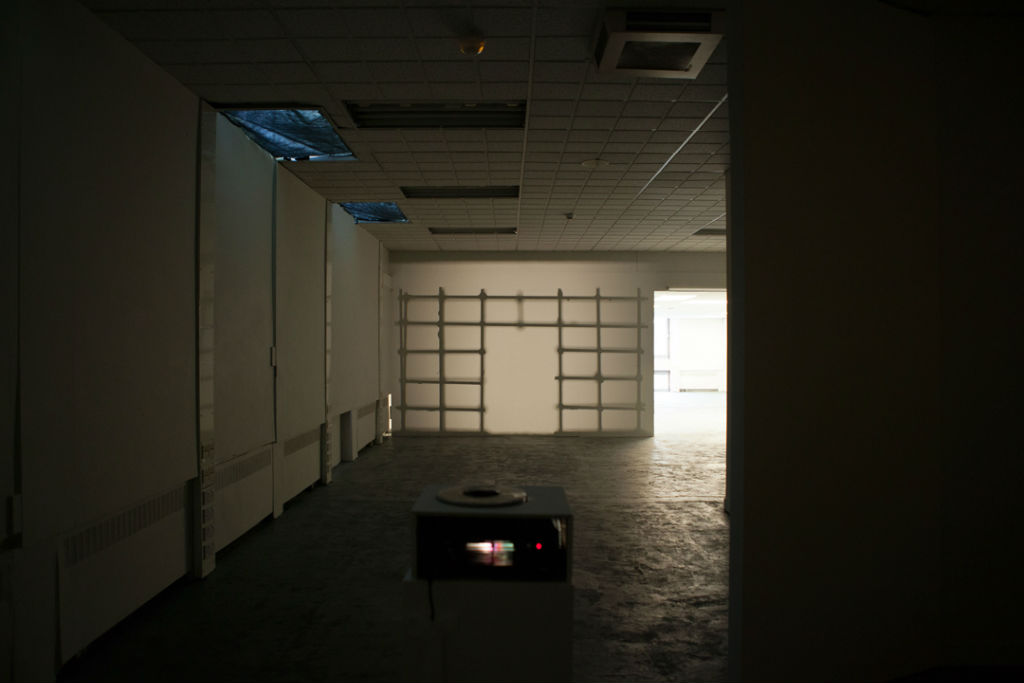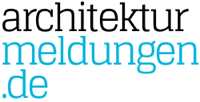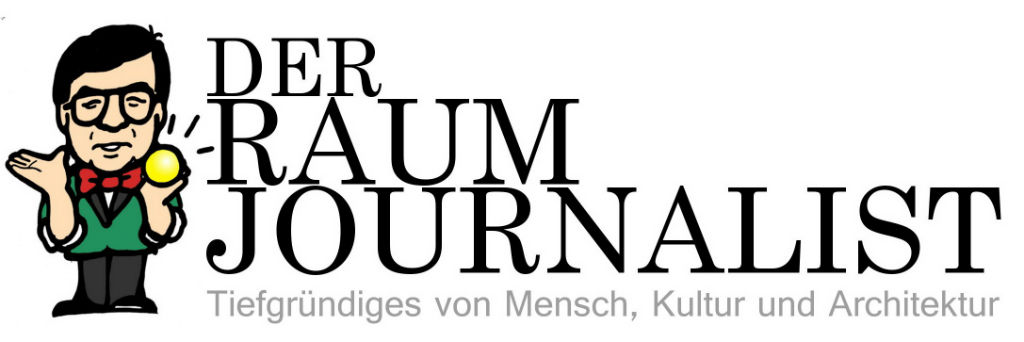„The process in making the painting seemed to follow a similar set of stages when designing a building – the plan, the model, the proposal images and resulting outcome.“ INTERVIEW with David McDiarmid
It is the peculiar charisma of megalomanic architecture that fascinates young Scottish artist David McDiarmid. Anyone who has experienced the Berlin Olympia Stadium or the „typewriter“-like Monument of Vittorio Emmanuele II in Rome knows about the strange tension betwen impressive colossalness and menace these buildings emanate. Even without considering the historically, politically charged (hi)stories of the edifices, their pure (over)size oozes a weird quality.
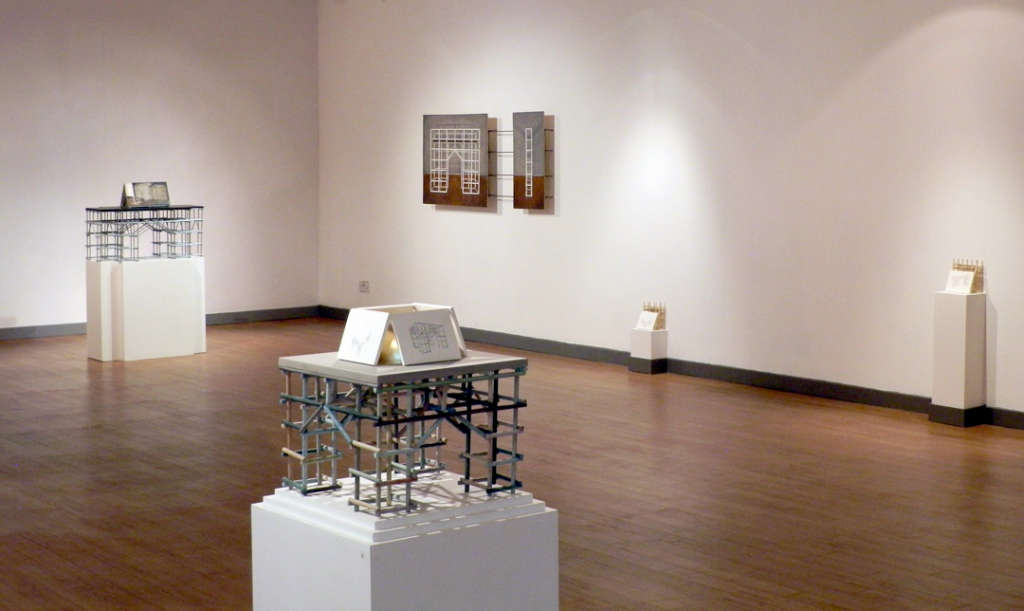
Megalomania exhibition, installation at Inverness Museum and Art Gallery, Image credit David McDiarmid
The Glasgow-based artist seeks to examine the concept of megalomania in architecture, the means by which the built environment is often purposefully designed, constructed and used as a tool for power and propaganda. He tries to delve into the ways in which architecture can subconsciously influence behaviours and emotions.
In producing his work McDiarmid incorporates materials and processes typically associated with architecture and construction. He often paints on surfaces cast with cement, plaster or concrete, juxtaposing them with precious materials such as gold leaf and faux marble to further explore the artifice of grandeur. Many of McDiarmid’s paintings and models play with ideas of scale and form, taking inspiration from historical examples of power architecture in order to depict ambitious plans and proposals for structures which will never exist in reality.
Also, scaffolding is a recurring motif in his work, its significance derived from its paradoxical position as both a fundamentally temporary structure, and its irrevocable status throughout the history of construction, where conceptually it time and again outlasts the permanent structures derived from it.
In his show at the Interview Room 11, in Edinburgh, in April, McDiarmid presented a culmination of the past three years of research, a site specific installation involving the large-scale projection of miniature scale models. At the end of July he will install a site specific installation at The Plinth, in Glasgow (27 July – 2 Aug).
After gradutating in 2013 in painting from Gray’s School of Art in Aberdeen, McDiarmid set up a studio in the city’s East end together with Visual Artist Unit, an art collective founded out of art school. He had his first solo exhibit at Inverness Museum and Art Gallery in 2014 and was part of the Royal Scottish Academy’s New Contemporaries exhibition.
With deconarch.com, David McDiarmit corresponded about the „attraction“ of megalomanic architecture, explained his working process and why he prefers exhibiting at „quirky spaces“.
all illus. (c) David McDiarmidÂ
davidmcdiarmid.co.uk
(or as indicated)
INTERVIEW
In your recent exhibition at the Interview Room 11 in Edinburgh, you presented a selection of works which can be considered a culmination of three years’ of research. Could you describe for us what the show was about?
For the exhibition at IR11 I presented a body of work focussing on the last 3 years of research into the architecture of power and megalomania. The exhibition features a major new site specific installation featuring the projection of miniature scale models showing the construction of a scaffolding structure piece by piece, with a separate set of wall-mounted models presented spearately and lit by spotlight. This work has been in the making since my Degree Show in 2013 The rest of the show consists of a series of installations of paintings with models along with a series of 125 plaster cast prints.
I am interested in presenting work in a way which reflects the way in which architecture can influence us subconsciously in a behavioural or emotional way. The work was installed at IR11 in such a way as to influence the way the viewer moves around the space and experiences not only the work but the space itself.
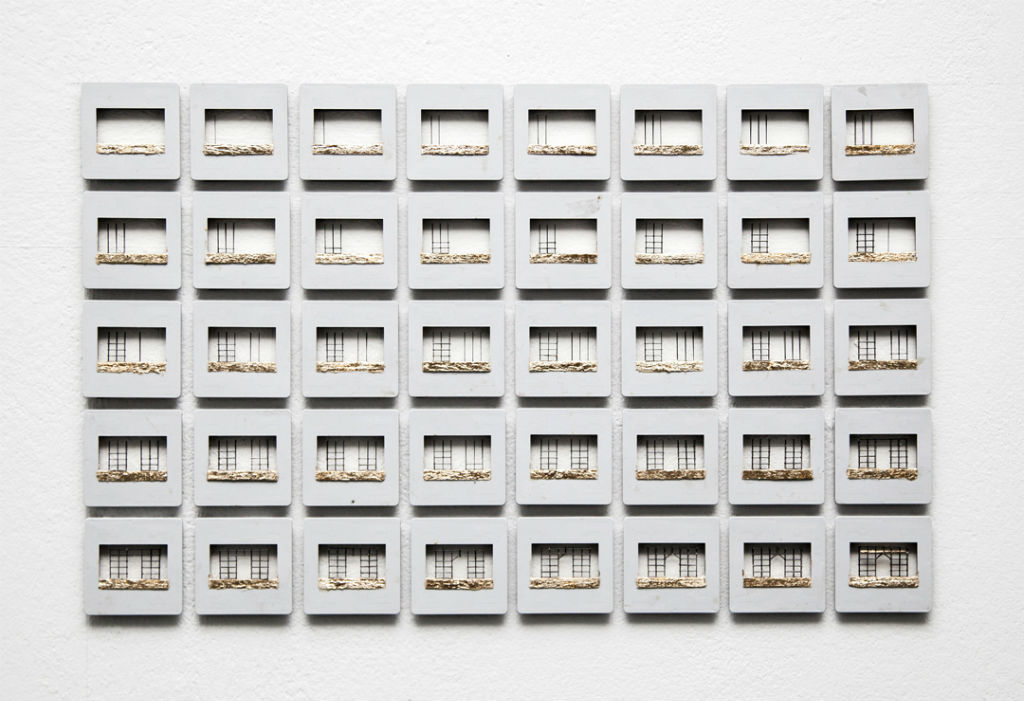
Model, Carbon fibre, balsa, gold and slide mounts, (Projection exhibition Interview Room 11, Image credit David Guillen 2015)
You prefer exhibiting at and working with “quirky“ spaces?
Indeed, I prefer presenting my work in more unusual spaces, making use of the unique aspects and quirks of the architecture for either presenting work or shaping the form of a new work. IR11 has numerous unusal aspects to the space, for example, there is one rounded corner where I have installed my piece Prop II (Basilica), a 3 dimensional work which encourgaes the viewer to follow the cruve of the wall and walk around the plinth piece to see all sides. One half of the gallery also has a very low ceiling with a skylight where I have installed my piece Abeyance which features the suspension of a model and two small paintings between the gallery wall and a purpose built pillar. Both of these works subconsciously influence the viewers’ movement through the space, yet, encourage them to take notice of certain aspects of the gallery’s architecture which they may have otherwise ignored altogether.
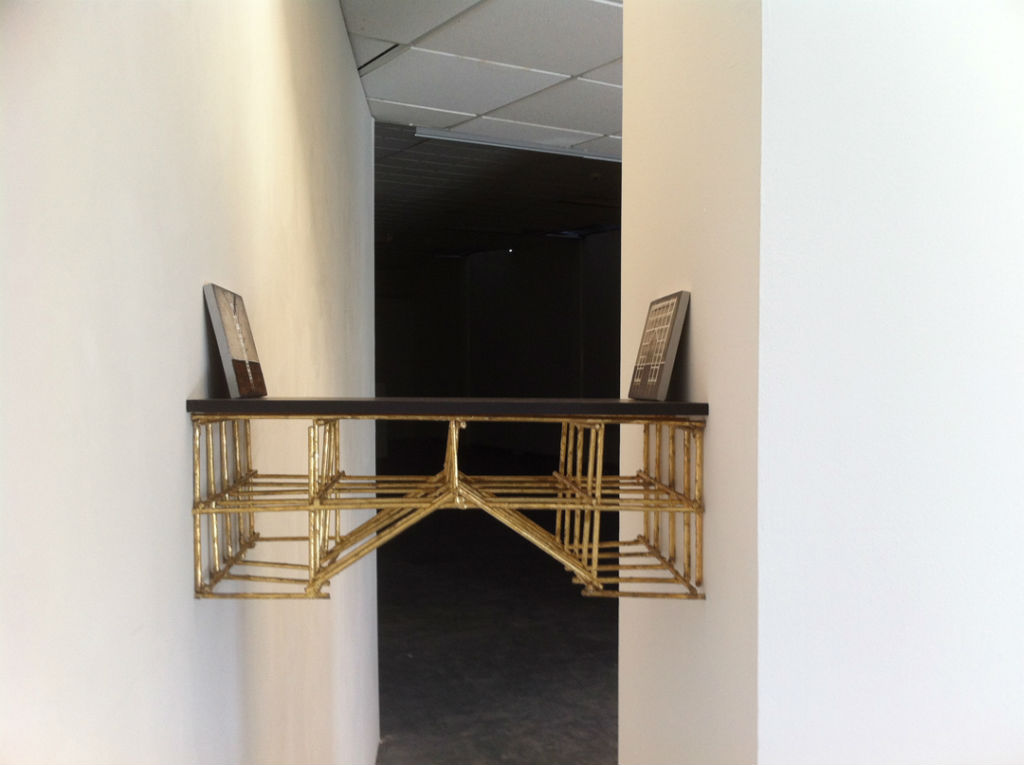
Abeyance, Watercolour and varnish on cement cast tiles with pine and gold leaf model suspended between wall and purpose built pillar (Projection exhibition Interview Room 11, Image credit David McDiarmid 2015)
What raised your interest in architecture …
When I was at school I seriously considered studying architecture. I have an uncle who is an architect and the idea of designing something so large and important as a building excited me! However, as I grew older I came to realise that I was more interested in the ideas behind buildings, and not so much designing them myself. I was more interested in pursuing a career in art which gave me more freedom to create than a career in architecture possibly ever would – a building needs to serve a purpose while art doesn’t necessarily.
… and in megalomaniac architecture in particular?
The interest in megalomania came about when I was in 2nd year at art school. I read a book about North Korea called Nothing To Envy by Barbara Demick which without being overly dramatic really changed the way I looked and thought about architecture. This was the first time I recognised the influence architecture can have on how we behave and began to take notice of how simple things in architecture such as the strategic installment of paving stones makes you follow a certain path.
I read Nothing To Envy around the time where various protests and rallies in city squares were being made against dictatorships such as Libya, Syria and Egypt, and at the time it looked like this might spread to North Korea. Further reading into past dictatorships such as the Soviets, Fascist Italy and Nazi Germany revealed more fascinating yet terrifying examples of how megalomania and the architecture of power can shape a country and influence how people behave. In 2012, I was awarded a scholarship to Berlin to study the architecture of the city. I was particularly interested in researching more into the plans for Germania which is where the arch motif that repeatedly appears and my work came from. The planned arch of triumph for Germania was directly inspired by and designed to be larger than the Arc de Triomphe in Paris. Pyongyang boasts an even larger arch of triumph, despite North Korea never having officially won a war. It is exactly these sorts of facts and snippets of information about the architecture of power that influence my work.
My research is, of course, not limited to totalitarian regimes, there are many examples in the democratic world where architecture has been designed and built as a tool for power and propaganda. A good example of this would be the ongoing design and construction for the World’s Tallest Buidling, which seems almost childish to me, yet nevertheless highlights this preoccupation with building big to make a statement and influence our beliefs about a place.
Where do you find your motives? Your topics?
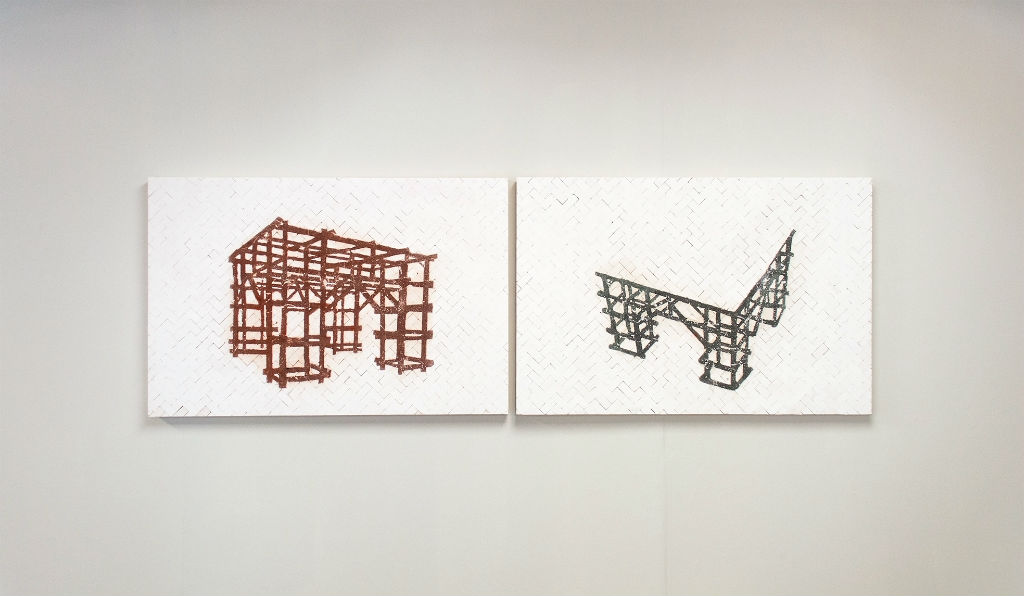
Megalomania IV, Plaster cast tiles with faux marble inlay (Projection exhibition, Interview Room 11, Image credit Laura Falcone 2015)
My topics come from various sources. I don’t read as much as I did throughout art school, yet have found the best inspiration from physically encountering aspects of architecture. I was lucky enough to have the opportunity to work in Venice last year during the Biennale which exposed me to many fascinating examples of architecture and the use of marble of construction, directly inspiring some of the pieces in the exhibition at IR11 such as Megalomania IV, which features a faux marble inlay.
More recently my work has become a lot more self-referential, with the subject of my ideas really not changing too much from what I was making in art school. I tend to repeat ideas and imagery a lot, and instead the focus has shifted to an emphasis on the process of making the work – how do I make this piece in a way which best reflects the ideas behind megalomania and delusions of grandeur? For example, the very idea of adapting certain parts of a gallery space to accomodate some of the works, such as installing the pillar at IR11 so that the paintings and models for Abeyance could be suspended from the gallery wall, for me, reflects well some of the aforementioned tendencies in the design of power architecture – it’s all in the hidden details!
My current thoughts on where to go next with the work, is to apply for some residencies in large cities. My time spent in Berlin and Venice seemed to have the most influence on the development of my work, and I’m intrigued to see what direction my work will take upon visiting and experiencing other cities and their architecture.
How is your working process? Are you working spontaneously or do you develop a concept?
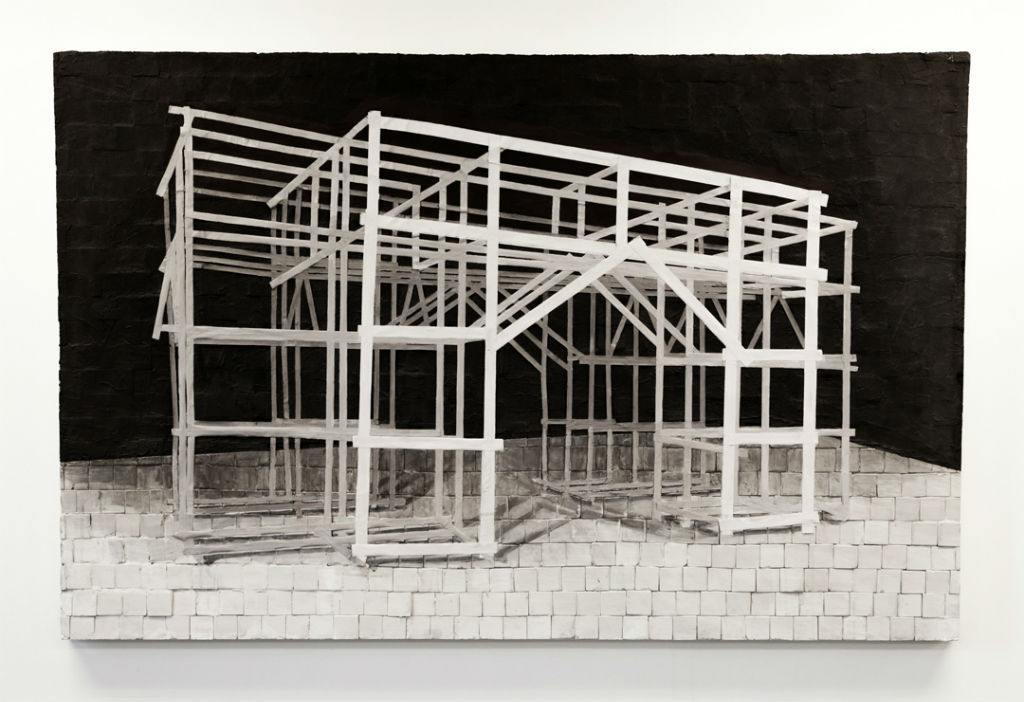
Megalomania II_ Acrylic, pigment and tape on cement cast tiles mounted on board (Projection exhibition, Interview Room 11, Image credit David Guillen 2015)
I have quite a short attention span in the studio so I like to work on lots of different pieces at once. I think this is also the reason why some of my works are made with an accumulative approach. For example, in the IR11 show, you have the large painting Megalomania II with its surface made from over 1000 individually cast cement tiles, as well as the series of 125 plaster cast prints. When working on these pieces I simply get in a routine of casting a set number of tiles per day, perhaps one set in the morning, one at night, allowing me time to work on other things during the day. There is something quite exciting for me in seeing a piece build up over time – the casting of tiles for the surface of the painting Megalomania II took over 2 months with the actual painting taking only a few weeks!
Megalomania II in fact went through a series of different stages and developments along the way. Initially there was the casting and grouting of tiles on to a board, the tile pattern for which was based on that of the main city sqaure in Pyongyang. This initial tiled board was then used as floor for a scaffolding model to sit on, thus becoming part of a sculpture. The model and board were then photographed, and so the board became a photographic image. The images I took from this set up were then used as the source imagery for painting on to the tiled board, resulting in the final outcome.
There is something interesting I found about the journey the painting took along the way – acting first as part of a model, then becoming a photographic image, before finally being turned into a painting itself. The process in making the painting seemed to follow a similar set of stages when designing a building – the plan, the model, the proposal images and resulting outcome.
Does this creative process also apply to “constructing“ of an exhibition?
I also like to plan the presentation and installation of my work well in advance. Of course you can only do this to a certain extent and as with the exhibition at IR11, I didn’t know where several pieces would be hung until the install of the show, however, I often visit the spaces I exhibit in at a few different times in the lead up to the show, often discovering different aspects of the architecture of the space which I’d like to use or incorporate in some way. With IR11, it became apparent quite early on, I wanted to split the space into a dark space and a light space, with a wall being built to separate the main installatiom Projection from the rest of the show, making use of some of the quirks of the space, such as the curved wall, skylight and pillars in the space, as mentioned above. In the past I have utilised the skirting board for paintings and models to be presented on as well as creating custom-built plinths and shelves to suit particular spaces. I find it interesting when a work can interact with the architecture of a space and not try to be separate from it, especially in an awkward or less conventional space.
What materials are you working with, and why?
I like to use materials which reflect and sit well with the subjects I address. Since a lot of the work is referencing construction and grandeur, it makes sense to use materials and processes typically associated with construction and architecture. For example, I tend to paint on cast surfaces such as cement or plaster instead of wood panels or canvas, and use processes such as casting, engraving, inlaying, gilding and woodwork/steelwork.
Are there role models, influences, … which inspire your work?
There are many artists I admire, particularly Ai Weiwei’s installations and Michael Borreman’s drawings. For example, the attention to detail and carefully considered processes involved in making Ai Weiwei’s sculptures and installations I find particularly interesting. I love that he employs traditionally skilled tradesmen to build his antique furniture sculptures – the installation of the works greatly benefit from this authentic finish and reflects well with the subjects he addresses.
I’m also influenced, perhaps unsurprisingly, by a lot of architects. However, in more general terms, I find inspiration from the way things are made or displayed and also find the levels of control and discipline involved in Chinese painting to be a particular influence. I’m not a very patient worker, which is funny because there are a lot of tedious and labour intensive processes involved in making my work, such as the casting, but I find it very important and beneficial to force myself to be!
 David, thanks so much for sharing!

